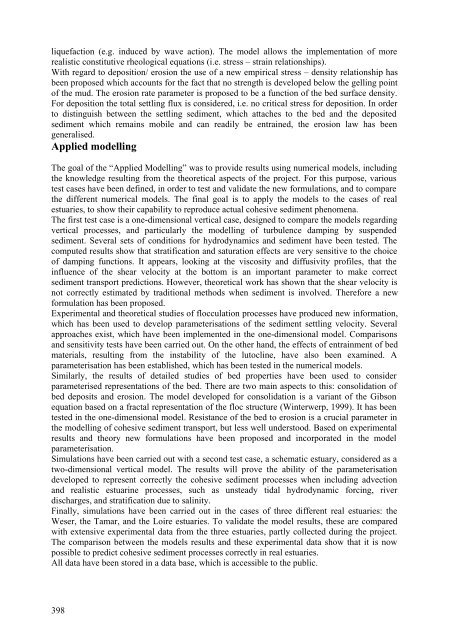EurOCEAN 2000 - Vlaams Instituut voor de Zee
EurOCEAN 2000 - Vlaams Instituut voor de Zee
EurOCEAN 2000 - Vlaams Instituut voor de Zee
You also want an ePaper? Increase the reach of your titles
YUMPU automatically turns print PDFs into web optimized ePapers that Google loves.
liquefaction (e.g. induced by wave action). The mo<strong>de</strong>l allows the implementation of more<br />
realistic constitutive rheological equations (i.e. stress – strain relationships).<br />
With regard to <strong>de</strong>position/ erosion the use of a new empirical stress – <strong>de</strong>nsity relationship has<br />
been proposed which accounts for the fact that no strength is <strong>de</strong>veloped below the gelling point<br />
of the mud. The erosion rate parameter is proposed to be a function of the bed surface <strong>de</strong>nsity.<br />
For <strong>de</strong>position the total settling flux is consi<strong>de</strong>red, i.e. no critical stress for <strong>de</strong>position. In or<strong>de</strong>r<br />
to distinguish between the settling sediment, which attaches to the bed and the <strong>de</strong>posited<br />
sediment which remains mobile and can readily be entrained, the erosion law has been<br />
generalised.<br />
Applied mo<strong>de</strong>lling<br />
The goal of the “Applied Mo<strong>de</strong>lling” was to provi<strong>de</strong> results using numerical mo<strong>de</strong>ls, including<br />
the knowledge resulting from the theoretical aspects of the project. For this purpose, various<br />
test cases have been <strong>de</strong>fined, in or<strong>de</strong>r to test and validate the new formulations, and to compare<br />
the different numerical mo<strong>de</strong>ls. The final goal is to apply the mo<strong>de</strong>ls to the cases of real<br />
estuaries, to show their capability to reproduce actual cohesive sediment phenomena.<br />
The first test case is a one-dimensional vertical case, <strong>de</strong>signed to compare the mo<strong>de</strong>ls regarding<br />
vertical processes, and particularly the mo<strong>de</strong>lling of turbulence damping by suspen<strong>de</strong>d<br />
sediment. Several sets of conditions for hydrodynamics and sediment have been tested. The<br />
computed results show that stratification and saturation effects are very sensitive to the choice<br />
of damping functions. It appears, looking at the viscosity and diffusivity profiles, that the<br />
influence of the shear velocity at the bottom is an important parameter to make correct<br />
sediment transport predictions. However, theoretical work has shown that the shear velocity is<br />
not correctly estimated by traditional methods when sediment is involved. Therefore a new<br />
formulation has been proposed.<br />
Experimental and theoretical studies of flocculation processes have produced new information,<br />
which has been used to <strong>de</strong>velop parameterisations of the sediment settling velocity. Several<br />
approaches exist, which have been implemented in the one-dimensional mo<strong>de</strong>l. Comparisons<br />
and sensitivity tests have been carried out. On the other hand, the effects of entrainment of bed<br />
materials, resulting from the instability of the lutocline, have also been examined. A<br />
parameterisation has been established, which has been tested in the numerical mo<strong>de</strong>ls.<br />
Similarly, the results of <strong>de</strong>tailed studies of bed properties have been used to consi<strong>de</strong>r<br />
parameterised representations of the bed. There are two main aspects to this: consolidation of<br />
bed <strong>de</strong>posits and erosion. The mo<strong>de</strong>l <strong>de</strong>veloped for consolidation is a variant of the Gibson<br />
equation based on a fractal representation of the floc structure (Winterwerp, 1999). It has been<br />
tested in the one-dimensional mo<strong>de</strong>l. Resistance of the bed to erosion is a crucial parameter in<br />
the mo<strong>de</strong>lling of cohesive sediment transport, but less well un<strong>de</strong>rstood. Based on experimental<br />
results and theory new formulations have been proposed and incorporated in the mo<strong>de</strong>l<br />
parameterisation.<br />
Simulations have been carried out with a second test case, a schematic estuary, consi<strong>de</strong>red as a<br />
two-dimensional vertical mo<strong>de</strong>l. The results will prove the ability of the parameterisation<br />
<strong>de</strong>veloped to represent correctly the cohesive sediment processes when including advection<br />
and realistic estuarine processes, such as unsteady tidal hydrodynamic forcing, river<br />
discharges, and stratification due to salinity.<br />
Finally, simulations have been carried out in the cases of three different real estuaries: the<br />
Weser, the Tamar, and the Loire estuaries. To validate the mo<strong>de</strong>l results, these are compared<br />
with extensive experimental data from the three estuaries, partly collected during the project.<br />
The comparison between the mo<strong>de</strong>ls results and these experimental data show that it is now<br />
possible to predict cohesive sediment processes correctly in real estuaries.<br />
All data have been stored in a data base, which is accessible to the public.<br />
398

















